SAY BYE TO PINTEREST PERFECTION AND HI TO REAL HOMES (AND REAL LIVES)
By Nicole Fuge
For years, social media has sold us a dream: the perfectly styled living room, the kitchen with spotless countertops, the bedroom lit by golden-hour sunshine filtered through linen curtains. But more and more women are stepping away from these carefully curated ideals to embrace something far more meaningful; homes that reflect their lives, not just their aesthetics.
It’s the rise of the lived-in look. And it’s rewriting the rules of what makes a house a home.
The Real Home Revolution
From Instagram to YouTube, a quiet revolution is underway. Women are pushing back against the pressure to present their homes as pristine showrooms. Instead, they’re opening the doors to real life with mismatched furniture, toddler chaos, books stacked in corners, and art that actually means something.
This shift isn’t just about resisting unrealistic beauty standards. It’s about reclaiming space. Space that honours the rhythms of life, the messiness of motherhood, the comfort of familiarity. Space that says, “I live here. I grow here”.
Beyond the Algorithm
Pinterest perfection may be beautiful, but it rarely tells the whole story. That farmhouse kitchen with the ceramic bowls and trailing ivy? It probably took three hours to clean and style. The minimalist bedroom with crisp white sheets? It’s likely just out of frame from a pile of laundry.
Women are increasingly tired of measuring their homes (and lives) against these glossy snapshots. There’s a growing desire to see homes that breathe, that hold history, that are alive with imperfection.
On TikTok and Instagram, accounts dedicated to “real home tours” are gaining momentum. They showcase spaces that reflect everyday life, a hand-me-down sofa, a scratched coffee table, a pantry that’s organised-ish. And people love it. Because it’s honest. Because it feels like home.
Soulful Spaces Over Styled Sets
There’s a certain kind of magic in a home that’s lived in. You can feel it in the scuffed floorboards that have carried a thousand footsteps, in the fridge door plastered with crayon drawings, in the corner chair that’s always got yesterday’s book draped over the arm.
These soulful spaces tell a story. They remind us that a home isn’t something to be constantly polished or upgraded, it’s a place to be. To laugh, to cry, to rest, to dream.
Letting Go of Shame
For many women, the shift to sharing real homes is also about letting go of shame. Shame about clutter, about the toy explosion in the lounge, about the dishes in the sink.
And as conversations around mental load, motherhood, and domestic expectations continue to evolve, so too does our relationship with the spaces we live in.
Showing a real home, with all its glorious imperfections, becomes a radical act of self-acceptance. It also fosters connection. When one woman shares her messy bookshelf or her chaotic morning routine corner, it gives others permission to exhale and say, “Same”.
A New Kind of Inspiration
The most inspiring homes now aren’t the ones with the biggest budgets or the sleekest furniture. They’re the ones that feel lived in and loved.
Think: second-hand treasures, bold paint choices that speak to personality over resale value, open shelving filled with mismatched mugs and holiday souvenirs.
This shift is also better for the planet. Embracing real, soulful spaces often means buying less, repurposing more, and valuing items for their stories instead of their hashtags.
Creating a Home, Not a Stage
Ultimately, this movement isn’t about anti-style, it’s about redefining style. One that centres you, not the algorithm.
You don’t need a trending coffee table or colour-coordinated bookshelves to have a beautiful home. You need presence. Personality. Pieces that reflect your life, your history, your joy.
Because the most powerful thing you can do in your home isn’t impress a stranger on social media, it’s to feel at ease in your own space.
So here’s to the real homes. The loud ones, the soft ones, the slightly chaotic ones. The homes filled with laughter, love and have fingerprints on the glass.
They’re not perfect. But they’re real. And that’s what makes them beautiful.
MUSE PAPER
ISSUE 05
